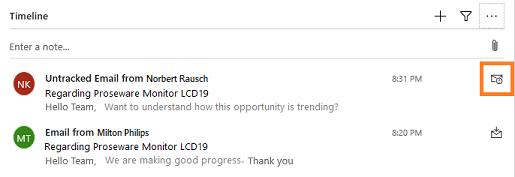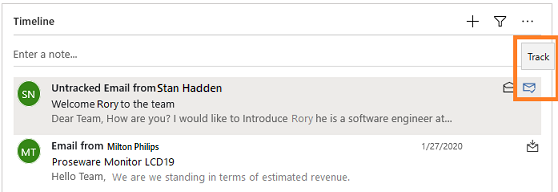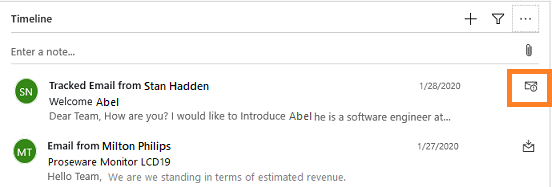Auto capture
Use the auto capture to capture activities related to your emails and contacts, and display on timeline.
License and role requirements
| Requirement type | You must have |
|---|---|
| License | Dynamics 365 Sales Premium or Dynamics 365 Sales Enterprise More information: Dynamics 365 Sales pricing |
| Security roles | Any primary sales role, such as salesperson or sales manager More information: Primary sales roles |
What is auto capture?
The activities captured by the auto capture feature are shown on the timeline in Dynamics 365 Sales. The feature finds activities by applying a set of rules that are specific to the record type. For example, when you look at an opportunity in Microsoft Dynamics 365 Sales, the timeline shows all the activities you've logged. Additionally, it shows suggestions for up to 50 recent emails and meetings from the last three days in your Outlook account that are related to the primary contact for the opportunity or its stakeholders.
Note
The appointment suggestion starts appearing on the timeline three days prior to the actual meeting time.
The following images show how tracked and auto-captured (not yet tracked) emails and meetings are displayed on the timeline:
Auto capture emails and meetings: These emails and meetings were detected by auto capture as being relevant to the current record, but they're still private, so only you can see them. Compared to tracked messages, these messages are shown as untracked emails or meetings. The following image shows an untracked email.

Note
From version 9.2.24031.00102, Dynamics 365 Sales follows principle of least privilege access, which blocks access to untracked emails and meetings for users who have conditional access policies on their tenants. If you don't see the untracked emails and meetings, contact your administrator to verify whether the issue is due to conditional access policies on your tenant. Alternatively, your administrator can enable Microsoft 365 Copilot for Sales in Outlook so that you can record individual activities or server-side synchronization to track all emails and meetings automatically.
Track link: Select the Track icon on an untracked activity captured by auto capture, making it visible to everyone who has access to the timeline of this specific record. The activities that auto capture finds are only visible to you, so other members of your sales team won't be able to see them in Dynamics 365 Sales. When you select the Track link on any auto-captured message, you turn it into a tracked email message, which saves the activity into the Dynamics 365 Sales database and makes it visible to other members of your team. It might take a few minutes for an activity to go from not being tracked to tracked, during which time it shows a Tracking pending message.

Tracked emails and meetings: The envelope symbol indicates that this email or meeting is already being tracked, so it's already imported into Sales and is being shared with your team.

As with other types of activity tiles shown on the timeline, you can select the tile to expand or collapse the content on the tile.
Which activities are captured?
Auto capture queries your Outlook account and looks for activities related to the record you're looking at. The following table summarizes how auto capture identifies related activities.
| Entity type | Matches these field values to the To, CC, or From address of each email and meeting |
|---|---|
| Account | Email address of the listed Primary Contact. Email addresses of the top 50 contacts that have the account as their parent account. All Email addresses defined for the account record itself. |
| Opportunity | Email address listed for the Opportunity Contact. Email address of any contact in the Stakeholders list. All Email addresses defined for the opportunity record itself. Email addresses of contacts of the account that is linked to the opportunity. If the opportunity is associated with a lead, Email address of the contact in the lead. |
| Lead | Email address listed in the Contact section. All Email addresses defined for the lead record itself. |
| Contact | All Email addresses defined for the contact record. |
| Custom entities | For account fields: the email address for the Primary Contact of the account, plus all Email addresses defined for the account record itself. For contact fields: all Email addresses defined for the contact record. For customer fields that refer to a contact: all Email addresses defined for the contact record. For customer fields that refer to an account: the Email address of the listed Primary Contact, plus all Email addresses defined for the account record itself. |